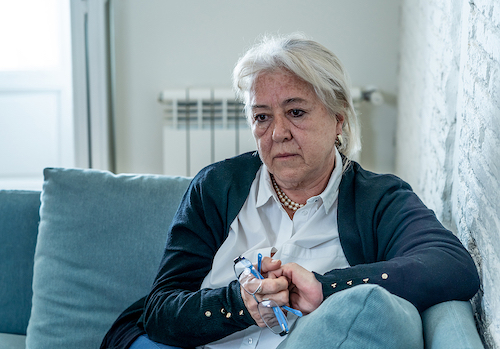 More than one million Americans have lost a close relation due to COVID-19, and that number is likely to rise.
More than one million Americans have lost a close relation due to COVID-19, and that number is likely to rise.
An analysis from the University of Southern California found that on average, for every COVID-19 death, there are nine people left to grieve. These include parents, grandparents, siblings, spouses and children.
With more than 140 thousand deaths due to COVID-19 in the United States, that amounts to more than 1.25 million people who are left to grieve.
“In the news cycle, the emphasis is on tracking the total number of lives lost, but what's missing is how these premature deaths reflect in family systems--what about the numerous loved ones left behind? Because many individuals who have died from COVID-19 were simultaneously a spouse, sibling, and child, and also a parent to multiple children or a grandparent to even more grandchildren, the collective toll of this mortality crisis is far greater when we start to think about all of the individuals bereaved by each death,” Emily Smith-Greenaway, author of the study and an associate professor of sociology and spatial sciences at the USC Dornsife College of Letters, Arts and Sciences told Theravive.
“We were motivated to generate a measure that allows us to tap into the collective burden of grief due to covid-19 losses, focusing specifically on family relations.”
Smith-Greenway and her colleagues developed a new indicator they called the “bereavement multiplier” to determine how many people are grieving due to a COVID-19 death in their family.
“When accounting for the average structure of American families and information on COVID-19 mortality patterns, we find that, on average, for every COVID-19 death in the U.S., nine individuals lose a close relative, which we define here as a grandparent, parent, sibling, spouse or child,” Smith-Greenaway explained.
“We find that this "bereavement multiplier" (which is =8.9 exactly) is stable across epidemiological trajectories, which allows us to track the bereavement burden in lockstep fashion with the rising death toll. Basically, anytime you want to understand how COVID-19 mortality is reverberating across American families, all you do is multiply the est. number of deaths by 8.9.”
At the time of writing, the US had experienced more than 146 thousand COVID-19 deaths. Using the bereavement multiplier, that amount to more than 1.2 million people grieving.
“In just a few months, more than 1.21 million Americans are suffering the death of a close relation. These are holes in families that can never be filled,” Smith-Greenaway said.
She says the burden of grief is disproportionately impacting certain groups in the community.
“What’s particularly concerning is that we see such an uneven burden of COVID-19 mortality in the U.S., especially in the Black community. It’s important that we pay mind to the disparities in mortality not just as evidence of a disparity but also a precursor to future disadvantage. Even as COVID-19 is very much a shared experience in our country, it is leaving a particularly traumatizing mark on some families and communities—so, I hope this research serves as a reminder for everyone to continue to take this seriously not only to reduce the likelihood that their own family is affected, but also to save others from this grief, trauma, and irreplaceable loss.”
By focusing on COVID-19 bereavement, the researchers are hopeful they will remind Americans that even when the pandemic is over, there will be a large burden of grief left behind. This can have flow on effects both mentally and physically for those grieving.
“After a family member dies, individuals are at risk of physical health problems and prolonged mental health consequences, like grief disorders, major depression, and anxiety. Also, we know that after losing a relative, individuals are at higher risk of worse physical health. It's possible that we see more of these adverse outcomes during the COVID-19 pandemic because of the sudden and traumatizing nature of these deaths, the inability to memorialize and celebrate with others—the forced solitary in grieving. These consequences may be compounded by individuals' own social isolation, lack of practical and emotional support,” Smith-Greenaway said.
“Of course, for the vast majority of bereaved individuals, the symptoms of grief will ultimately diminish, which reflects human resilience, but there are certainly ways that public health efforts could speed this and support this resiliency. We should recognize that bereavement is a major public health issue that needs attention and resources to help individuals to heal from their losses,” she said.
The researchers say their work also serves as a reminder that although young people may not account for as many deaths, they are still being impacted by COVID-19.
“Even as there has been tremendous focus on the steep age-gradient in COVID-19 hospitalizations and deaths, our study reminds us that many young people are intimately suffering from COVID-19 mortality through the sudden death of their parents or grandparents,” she said.
“We estimate more than half a million young people have already lost a grandparent to COVID-19 in the U.S. So, young people will not be left unscathed by this crisis. What must remind young people that every time they stay home or, when they go out, mask up and physically distance, they’re helping to avoid a new infection, a potential loss of life, and in turn, are protecting several individuals from the grief and trauma that corresponds with the premature death of a relative.”
Elizabeth Pratt is a medical journalist and producer. Her work has appeared on Healthline, The Huffington Post, Fox News, The Australian Broadcasting Corporation, The Sydney Morning Herald, News.com.au, Escape, The Cusp and Skyscanner. You can read more of her articles here. Or learn more about Elizabeth and contact her via her LinkedIn and Twitter profiles.